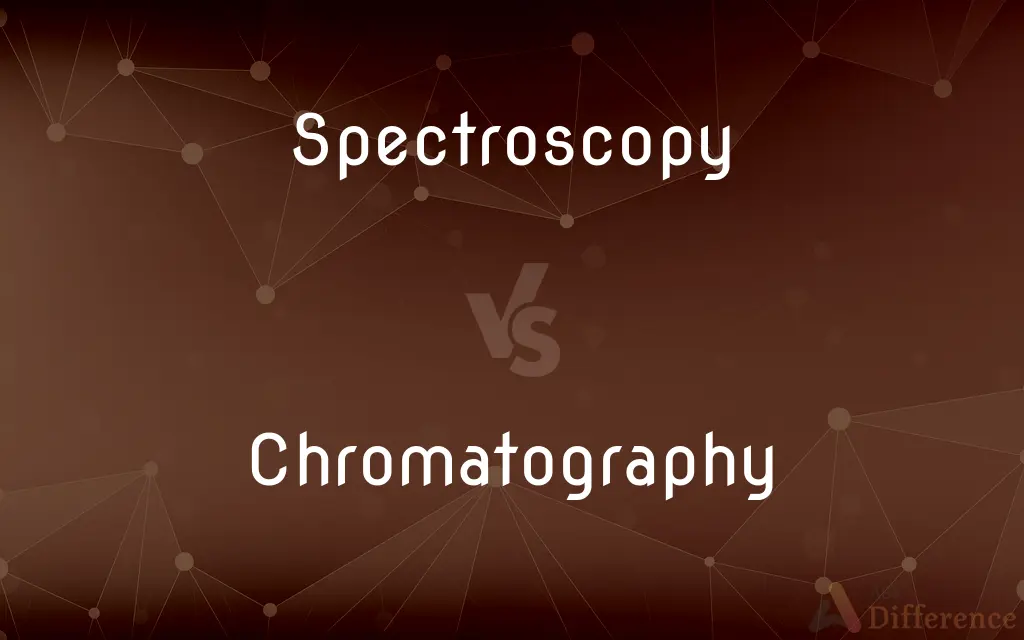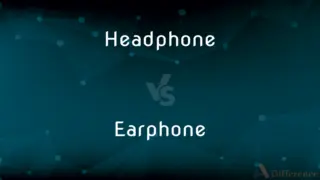Spectroscopy vs. Chromatography — What's the Difference?
By Urooj Arif & Maham Liaqat — Updated on March 11, 2024
Spectroscopy analyzes light to identify materials, whereas chromatography separates mixtures for analysis.

Difference Between Spectroscopy and Chromatography
Table of Contents
ADVERTISEMENT
Key Differences
Spectroscopy involves the interaction between light and matter to analyze the composition, structure, and physical properties of substances. It measures the spectrum of light absorbed, emitted, or scattered by materials, allowing scientists to identify chemical compounds and understand molecular structures. On the other hand, chromatography is a technique used to separate the components of a mixture based on differences in their movement through a stationary phase under the influence of a mobile phase. This separation allows for the identification and quantification of the mixture's components.
While spectroscopy focuses on the electromagnetic spectrum's role in identifying substances, chromatography emphasizes physical separation processes. Spectroscopy can provide detailed information about the electronic and structural properties of molecules, including their energy levels, molecular bonds, and functional groups. Conversely, chromatography is effective in purifying substances and analyzing complex mixtures, making it invaluable in fields like biochemistry, environmental analysis, and pharmaceuticals.
The principles underlying spectroscopy and chromatography differ significantly. Spectroscopy relies on the principle that different molecules absorb or emit electromagnetic radiation at specific wavelengths, leading to unique spectral fingerprints. Chromatography, however, is based on the differential partitioning of components between a mobile phase (liquid or gas) and a stationary phase (solid or liquid), resulting in the separation of mixture components over time.
Applications of spectroscopy and chromatography vary widely, highlighting their complementary roles in scientific research and industry. Spectroscopy is widely used in chemical analysis, materials science, and astronomy to identify substances and analyze cosmic objects. Chromatography is indispensable in analytical chemistry, especially for quality control, drug testing, and separating complex biological samples.
While both techniques are crucial for the analysis of substances, their methods, principles, and applications highlight distinct aspects of chemical and physical analysis. Spectroscopy sheds light on the intrinsic properties of materials through their interaction with electromagnetic radiation, while chromatography unravels the complexity of mixtures by physically separating their constituents.
ADVERTISEMENT
Comparison Chart
Principle
Interaction of light with matter
Separation based on differential movement through stationary and mobile phases
Focus
Identifying chemical composition and structure
Separating and analyzing components of a mixture
Method
Measures absorbed, emitted, or scattered light
Utilizes differential partitioning between stationary and mobile phases
Applications
Chemical analysis, materials science, astronomy
Biochemistry, environmental analysis, pharmaceuticals
Information Provided
Molecular structure, energy levels, functional groups
Composition of mixtures, purity of substances
Compare with Definitions
Spectroscopy
Technique for analyzing light's interaction with matter.
Spectroscopy revealed the molecular composition of the sample.
Chromatography
Essential in drug testing.
Gas chromatography is commonly used for the analysis of blood samples in doping tests.
Spectroscopy
Determines molecular structures.
NMR spectroscopy provides detailed information about the structure of molecules.
Chromatography
Method for separating mixture components.
Chromatography was used to purify the chemical compounds.
Spectroscopy
Measures spectral fingerprints.
UV-visible spectroscopy measures the absorption of light by substances.
Chromatography
Utilizes stationary and mobile phases.
In liquid chromatography. the mobile phase moves through the stationary phase.
Spectroscopy
Used in identifying substances.
Infrared spectroscopy identifies organic compounds by their functional groups.
Chromatography
Conducts environmental analysis.
Chromatography helps in detecting pollutants in water samples.
Spectroscopy
Analyzes astronomical objects.
Astronomers use spectroscopy to determine the composition of stars.
Chromatography
Analyzes complex biological samples.
High-performance liquid chromatography separates proteins in a sample.
Spectroscopy
Spectroscopy is the study of the interaction between matter and electromagnetic radiation as a function of the wavelength or frequency of the radiation. In simpler terms, spectroscopy is the precise study of color as generalized from visible light to all bands of the electromagnetic spectrum; indeed, historically, spectroscopy originated as the study of the wavelength dependence of the absorption by gas phase matter of visible light dispersed by a prism.
Chromatography
Chromatography is a laboratory technique for the separation of a mixture. The mixture is dissolved in a fluid (gas or solvent) called the mobile phase, which carries it through a system (a column, a capillary tube, a plate, or a sheet) on which is fixed a material called the stationary phase.
Spectroscopy
The study of spectra, especially experimental observation of optical spectra or mass spectra, to determine the properties of their source.
Chromatography
Any of various techniques for the separation of complex mixtures that rely on the differential affinities of substances for a mobile (gas or liquid) medium and for a stationary adsorbing (liquid or solid) medium through which they pass, such as paper, gelatin, or silica.
Spectroscopy
A variety or instance of such study.
Chromatography
(analytical chemistry) Any of various techniques for the qualitative or quantitative separation of the components of mixtures of compounds; all characterised by the use of a mobile phase (gas or liquid) moving relative to a stationary phase (liquid or solid) – the differences between the rates of migration of the compounds between the two phases effects the separation.
Spectroscopy
(uncountable) The scientific study of spectra.
Chromatography
A treatise on colors
Spectroscopy
The use of spectrometers in chemical analysis.
Chromatography
An analytical and preparative technique for separating substances by differences in their selective adsorption to solids, by passing a liquid over the solid, to which the substances to be separated have usually been adsorbed in a preliminary step. The major variations are column chromatography, in which the substances to be separated are adsorbed to a column with any of a wide variety of adsorbing solids in powdered or granulated form; paper chromatography, in which the solids are applied as a spot at one end of a strip of absorbent paper (such as filter paper), and the liquid is percolated through the paper by capillary action; and thin-layer chromatography (TLC), which is similar to paper chromatography, but the adsorbent material is, instead of paper, a thin layer of finely powdered material, such as cellulose or silica, on a backing of glass or plastic, called a TLC plate. A modern version of column chromatography is high-performance liquid chromatography, usually referred to as HPLC.
Spectroscopy
The art and science dealing with the use of a spectroscope, and the production and analysis of spectra; the action of using a spectroscope.
Chromatography
A process used for separating mixtures by virtue of differences in absorbency
Spectroscopy
The use of spectroscopes to analyze spectra
Common Curiosities
What is spectroscopy?
Spectroscopy is a technique that analyzes how light interacts with matter to identify substances and their structures.
Can spectroscopy and chromatography be used together?
Yes, they are often used in conjunction to separate, identify, and analyze substances in complex mixtures.
How does spectroscopy differ from chromatography?
Spectroscopy identifies and analyzes substances through light interactions, while chromatography separates mixtures into their components for analysis.
What is chromatography?
Chromatography is a method used to separate the components of a mixture based on their differential movement through stationary and mobile phases.
What are the applications of spectroscopy?
It's used in chemical analysis, materials science, and studying the composition of astronomical objects.
What principle does chromatography rely on?
It relies on the differential partitioning of mixture components between stationary and mobile phases.
What makes chromatography essential in pharmaceuticals?
It's crucial for ensuring the purity and safety of pharmaceutical products.
Is spectroscopy useful in astronomy?
Yes, it's essential for determining the composition and properties of astronomical objects.
How do scientists choose between spectroscopy and chromatography?
The choice depends on the analysis goal, whether it's identifying substances (spectroscopy) or separating and analyzing mixture components (chromatography).
Can chromatography purify substances?
Yes, it can purify substances by separating them from mixtures.
What are the applications of chromatography?
It's widely used in biochemistry, pharmaceuticals, environmental analysis, and quality control.
What is the principle behind spectroscopy?
It's based on the specific wavelengths of light absorbed, emitted, or scattered by different substances.
What is a spectral fingerprint in spectroscopy?
It's a unique pattern of light absorption or emission that can identify specific substances.
What is a common use of chromatography in environmental science?
It's used to detect and quantify pollutants in environmental samples.
Can spectroscopy determine molecular structure?
Yes, techniques like NMR spectroscopy can provide detailed molecular structure information.
Share Your Discovery

Previous Comparison
Ghastly vs. Fatal
Next Comparison
Headphone vs. EarphoneAuthor Spotlight
Written by
Urooj ArifUrooj is a skilled content writer at Ask Difference, known for her exceptional ability to simplify complex topics into engaging and informative content. With a passion for research and a flair for clear, concise writing, she consistently delivers articles that resonate with our diverse audience.
Co-written by
Maham Liaqat













































